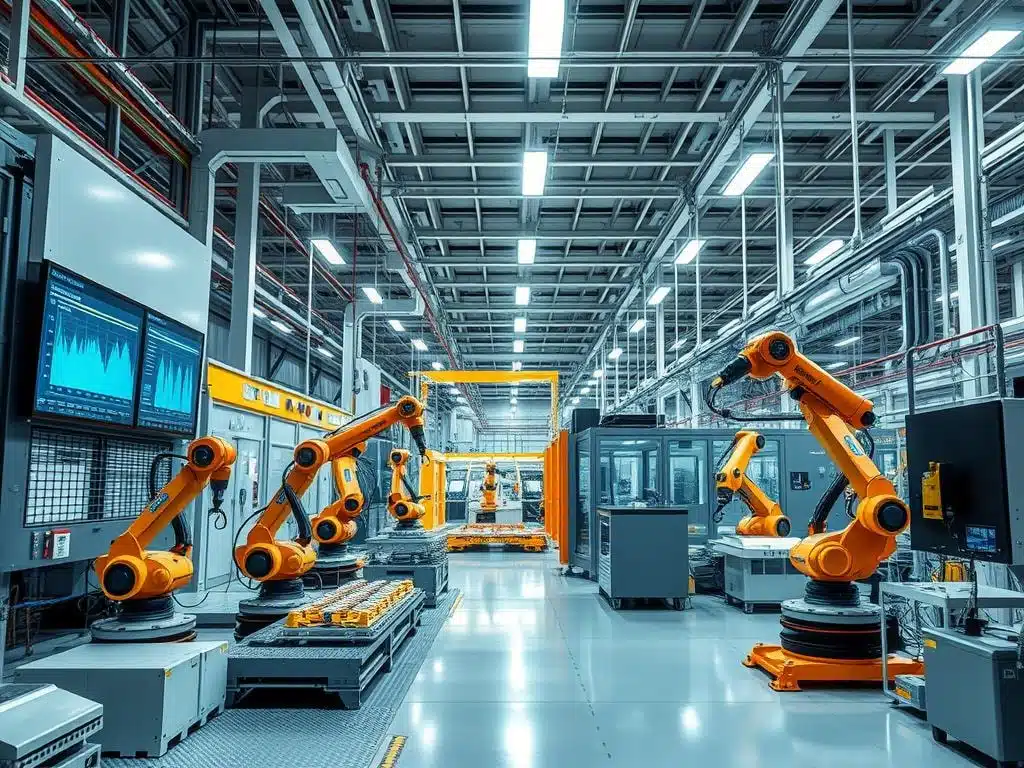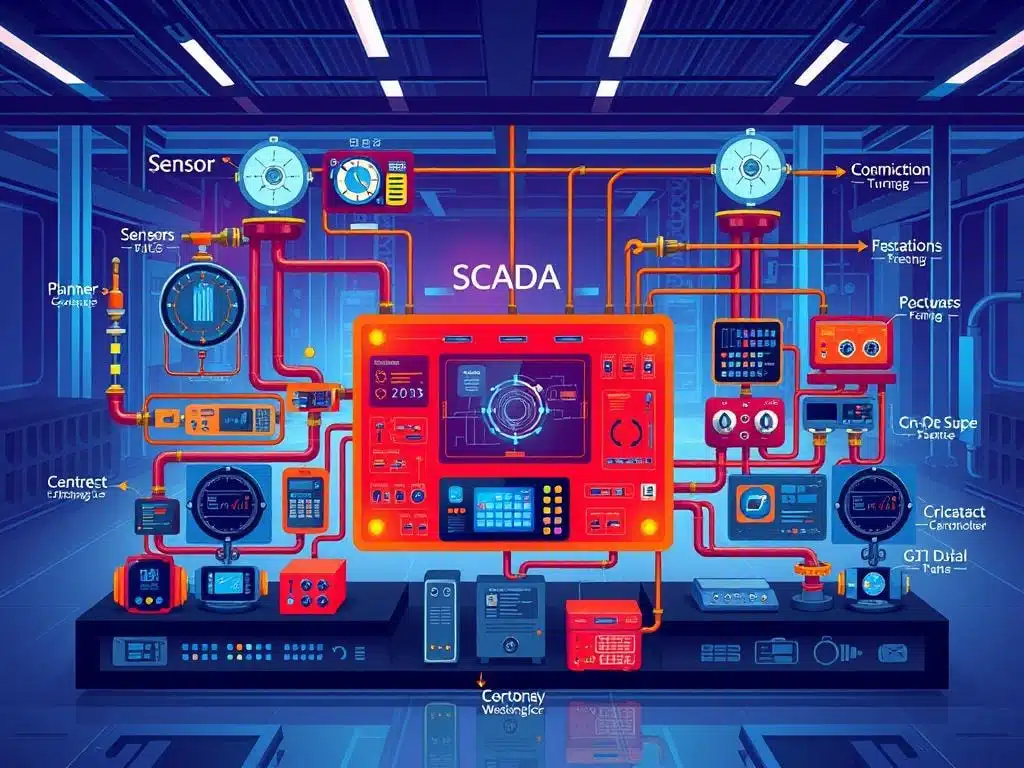Industries manage vast, intricate systems seamlessly with the help of Guide of SCADA (Supervisory Control and Data Acquisition) systems. These sophisticated platforms have revolutionized business operations, driving efficiency and safety across sectors. Let’s explore this in Guide of SCADA working mechanisms, practical applications, and benefits.
SCADA systems have evolved from rudimentary control systems to industrial automation powerhouses. They enable remote monitoring and process control in industrial manufacturing, energy distribution, water treatment, and transportation. These systems streamline operations and optimize performance across industries.
Sensors and actuators form the core of SCADA systems. Sensors gather environmental data like temperature and pressure. Actuators receive signals and initiate physical actions, such as valve operations.
Remote Terminal Units (RTUs) and Programmable Logic Controllers (PLCs) bridge devices and the central SCADA system. They ensure smooth communication and control between components. This integration creates a comprehensive solution for data management and system control.
The Human-Machine Interface (HMI) is vital to SCADA operations. It provides operators with real-time data, control functions, and alarm notifications. Communication protocols like Modbus, DNP3, or OPC ensure optimal performance and reliability in SCADA systems.
Key Takeaways
SCADA systems have evolved into sophisticated platforms driving efficiency and safety across various industries.
Sensors and actuators play a crucial role in data collection and physical control within SCADA systems.
RTUs and PLCs serve as intermediaries between devices and the central SCADA system.
The Human-Machine Interface (HMI) provides operators with real-time data, control functionalities, and alarm notifications.
Choosing the right communication protocol is essential for optimal performance and reliability in SCADA systems.
What are SCADA Systems?
SCADA systems form the core of industrial automation, managing complex machinery and processes. They’re crucial in manufacturing, water management, oil and gas, transportation, and energy sectors. In the manufacturing process, SCADA systems monitor and control different stages, from raw material entry to final production outcomes. SCADA International has implemented over 6,000 solutions across 29 countries.
These systems excel in real-time data collection, process monitoring, and control functions. They optimize production, troubleshoot processes, and enable remote equipment control. This includes wind turbines, solar PV modules, and hydropower plants.
In renewable energy, SCADA systems ensure grid regulation compliance and enhance plant performance. The IEC 61400-25 standard governs wind power plant monitoring and control. SCADA International’s Global Wind Data Tag-List covers 2,600+ data points for wind turbines.
Their OneView® SCADA software provides unified control and monitoring for renewable assets. This streamlines operations and improves efficiency across various renewable energy sources.
Industry | SCADA Application |
|---|---|
Manufacturing | Process control, quality monitoring |
Water Management | Treatment, distribution, and collection |
Oil and Gas | Extraction, transportation, refining |
Renewable Energy | Wind, solar, hydropower monitoring and control |
SCADA systems have evolved from mainframe-based monoliths to distributed systems with LAN technology. Modern SCADA systems boast open architectures and non-vendor-specific protocols. They provide real-time plant floor data access, enabling data-driven process improvements.
Ignition by Inductive Automation® has been installed in thousands of locations across 100+ countries since 2010. This showcases the widespread adoption and versatility of modern SCADA solutions.
SCADA systems maintain efficiency, process data for smarter decisions, and communicate system issues. They mitigate downtime and have become essential in industrial organizations. As technology advances, SCADA systems will continue optimizing processes across various sectors.
Working Mechanism of SCADA
SCADA systems employ a sophisticated process to monitor and control industrial operations in real-time. They utilize a continuous feedback loop for data acquisition, transmission, processing, and control.
Data Acquisition
SCADA begins by collecting data from field devices like sensors, remote terminal units (RTUs), and programmable logic controllers (PLCs). These devices measure critical parameters such as temperature, pressure, and flow rate.
The collected data provides valuable insights into system performance. It forms the foundation for effective monitoring and control in industrial settings.
Data Transmission
After acquisition, data is transmitted to a central control system for processing. This transmission uses communication protocols like Modbus, Profibus, or Ethernet.
The communication infrastructure may include wired or wireless networks. The choice depends on system requirements and the operational environment.
Data Processing
SCADA software processes the transmitted data, analyzing and presenting it through a human-machine interface (HMI). The HMI displays real-time data, trends, and alarms, enabling informed decision-making.
Operators can use this information to make necessary adjustments and optimize system performance. The processed data forms the basis for effective control actions.
Monitoring and Control
Operators monitor system performance and make adjustments based on processed data. SCADA allows remote control of field devices, enabling equipment management and setpoint adjustments.
This dynamic control capability is crucial for maintaining optimal performance. It allows quick responses to changing conditions in real-time.
SCADA systems are crucial in manufacturing, where they automate production lines, manage assembly operations, and monitor product quality, resulting in enhanced efficiency and productivity levels.
SCADA systems store historical data for trend analysis and performance benchmarking. This data helps identify potential issues before they escalate and optimize maintenance schedules.
By leveraging historical data, industries can improve overall system efficiency. It also aids in predictive maintenance, reducing downtime and operational costs.
Industry | SCADA Application |
|---|---|
Power Generation | Monitoring and controlling power plants, transmission, and distribution systems |
Oil and Gas | Monitoring and controlling extraction, processing, and transportation processes |
Water Treatment | Monitoring and controlling water treatment plants, distribution networks, and wastewater systems |
Manufacturing | Automating production lines, managing assembly operations, and monitoring product quality |
SCADA systems showcase versatility and effectiveness in managing complex industrial processes. They optimize operations, reduce downtime, and enhance overall efficiency through real-time data management.
By integrating various components, SCADA creates a robust system for industrial control. Its adaptability makes it invaluable across diverse sectors, from power generation to manufacturing.
Practical Applications of SCADA
SCADA systems have transformed industry operations, enabling efficient manufacturing automation, energy management, and more. In the modern industrial landscape, these systems are essential for improving efficiency, reducing costs, and enhancing safety. These versatile systems are used across sectors like electric power, telecom, traffic control, and building management. They improve service quality, reliability, and reduce costs.
In power sectors, SCADA is vital for operational planning, fuel scheduling, and network security. It enhances efficiency in power generation, transmission, and distribution. Substation SCADA offers advanced features like remote control and safety tagging.
These systems provide real-time monitoring, fault detection, and preventive maintenance. They ensure optimal performance and minimal downtime. Power network utilities software, powered by SCADA, enhances electrical utilities operation cost-effectively through real-time data.
Key features include:
Component modeling
State estimation
Fault isolation
Load shedding
Dispatcher power flow
Network topology processing
SCADA systems are crucial in manufacturing, automating production lines effectively. In oil and gas, they facilitate efficient extraction and processing. For water treatment, SCADA monitors and controls processes, ensuring quality and safety.
Industry | SCADA Application | Benefits |
|---|---|---|
Manufacturing | Automation of production lines | Increased efficiency, reduced labor costs |
Oil and Gas | Extraction and processing monitoring | Improved safety, optimized production |
Water Treatment | Process control and monitoring | Ensured quality, reduced waste |
Transportation | Traffic management and control | Optimized flow, enhanced safety |
Transportation benefits from SCADA in traffic management, elevator systems, and mass transit. It optimizes traffic flow and enhances safety, contributing to efficient transportation networks. SCADA adapts to new challenges, integrating with IoT for greater automation and control.
SCADA remains essential for businesses aiming to streamline operations and improve performance. Its wide-ranging applications and proven benefits make it indispensable across various industries. As technology evolves, SCADA continues to play a crucial role in industrial advancement.
Key Benefits of Implementing SCADA Systems
SCADA systems boost operational efficiency, productivity, and safety across industries. They offer advanced monitoring, control, and data analysis capabilities. These systems streamline processes and enable informed decisions based on real-time insights.
Real-Time Data Analysis
SCADA systems excel at sophisticated data analysis in real-time. They continuously monitor processes and equipment, allowing quick issue identification. Operators can address inefficiencies promptly, optimizing operations and preventing potential disruptions.
Reduced Downtime
SCADA systems minimize downtime through swift fault detection and predictive maintenance. They monitor equipment performance and analyze data trends to identify potential issues early. This proactive approach pinpoints root causes of failures, ensuring optimal asset utilization.
These systems provide different alarm priorities for timely reactions. Automated controls enable remote equipment operation through control relays. Customized alerts ensure relevant personnel receive notifications for quick response.
Improved Quality Control
SCADA systems maintain consistent product quality through real-time checks. They monitor production processes and collect data to identify quality deviations. Operators can take immediate corrective measures, ensuring products meet desired specifications.
Enhanced Safety
Safety is crucial in many industries, and SCADA systems play a vital role. They monitor hazardous processes and provide real-time data on potential risks. This includes monitoring environmental conditions, detecting leaks, and ensuring safety protocol adherence.
SCADA systems offer cost savings through operational efficiency and increased asset longevity. They provide valuable data recording and reporting capabilities for strategic planning. Detailed reports compile data for performance evaluation and trend identification.
Benefit | Description |
|---|---|
Improved Performance | Approximately 24% of manufacturing companies have reported improved performance by becoming more agile in their business, operations, and processes through SCADA implementation. |
Reduced Downtime | SCADA systems can reduce downtime, boost productivity, and help save money by enabling swift responses to equipment failures or process deviations. |
Consistent Product Quality | SCADA contributes to maintaining consistent product quality in manufacturing by conducting real-time quality checks and enabling prompt actions against quality deviations. |
Centralized Data Collection | SCADA systems centralize data collection, providing a unified view of production data and critical information from a single user interface. |
Core Components & In-Depth Understanding of SCADA Systems
SCADA systems are complex networks of devices and software that monitor and control industrial processes. Sensors and actuators act as the system’s eyes and hands. They gather real-time data and execute control actions based on supervisory computer decisions.
Remote Terminal Units (RTUs) bridge field devices and the central control room. They collect and convert sensor data for transmission to supervisory computers. RTUs also relay commands from the control room to actuators, ensuring seamless process control.
The Human-Machine Interface (HMI) connects operators with the SCADA system. It displays data in a user-friendly format for monitoring and decision-making. Operators use the HMI to input commands and adjust parameters, maintaining optimal performance and responding to emergencies.
Supervisory computers are the SCADA system’s brain. They process field data and make decisions based on algorithms and thresholds. These computers analyze data, compare trends, and generate alerts for deviations. They also execute complex control strategies to meet production targets.
Integrating these core components is crucial for effective SCADA system functioning. The table below outlines typical costs for implementing a SCADA system:
Component | Cost Range |
|---|---|
Network Map Documentation | $800 – $1,600 |
Ethernet CAT5 Cable Installation | $7.00 – $10.00 per linear foot |
Rockwell Automation FactoryTalk® View SE HMI SCADA Software (up to 10 HMI client stations) | $6,143.00 |
Windows 10 Enterprise Intel® Core™ i5 with 8GB of RAM DELL OPTIPLEX 3070 Business Desktop PC | $989.99 |
Industrial Router | $200 – $1,400 |
Integration Cost for Installing Rockwell Automation FactoryTalk® View SE HMI SCADA Software on the Computer Server | $1,200 – $1,800 |
Programming Cost for SCADA Systems (per hour) | $150.00 – $225.00 |
Cost estimates may vary based on project requirements and integrator expertise. Understanding SCADA system components helps industries make informed decisions when implementing or upgrading infrastructure. This knowledge ensures optimal performance and cost-effectiveness in industrial process management.
Types of SCADA Systems
SCADA systems have evolved to keep up with industrial automation advancements. They’ve transformed from single-facility systems to technology that integrates IoT, cloud computing, and big data analytics. This evolution has produced four distinct types of SCADA systems.
Monolithic SCADA Systems
Monolithic SCADA systems are basic and found in smaller environments. They offer centralized control with all components in one location. These systems provide simple process automation but lack flexibility and scalability for modern industrial needs.
Distributed SCADA Systems
Distributed SCADA systems improve upon monolithic ones by decentralizing control. They enable communication between multiple SCADA systems, offering enhanced redundancy and reliability. This type suits larger industrial operations spanning multiple sites or integrating diverse equipment and processes.
Distributed SCADA provides a comprehensive view of operations. It allows companies to respond more effectively to changing conditions in their industrial processes.
Networked SCADA Systems
Networked SCADA systems are preferred by large industrial sectors. They use advanced communication technologies like optical fiber and Ethernet for data transmission. These systems connect multiple SCADA setups through robust network infrastructure.
This approach enables unprecedented integration, collaboration, and real-time data sharing. Operators can monitor and control processes remotely, reducing on-site personnel needs and improving efficiency.
IoT-Integrated SCADA Systems
IoT-integrated SCADA represents the cutting edge of industrial automation. It incorporates cloud computing and IoT, offering unparalleled flexibility, scalability, and cost-effectiveness. These systems seamlessly integrate diverse devices and data sources.
IoT SCADA allows companies to harness the full potential of their industrial data. With reduced infrastructure costs and simplified maintenance, these systems are revolutionizing industrial operations in the digital age.
Understanding each SCADA system type helps companies make informed decisions. They can choose the architecture that best suits their specific needs and goals for efficient, reliable, and secure operations.
The Critical Role of SCADA in Various Industries
SCADA systems are crucial for managing complex industrial processes across diverse sectors. They enable real-time monitoring, control, and optimization of operations. This leads to improved efficiency, enhanced safety, and significant cost savings in manufacturing, energy grids, and water management systems.
In manufacturing, SCADA software monitors production lines and machinery conditions. It tracks key performance indicators and equipment health. This helps identify potential issues early, minimize downtime, and maximize productivity.
In the energy sector, SCADA systems are vital for power generation, transmission, and distribution. They ensure a reliable and stable supply of electricity to consumers.
Water treatment plants rely on SCADA systems for managing supply and wastewater processes. These systems automate control and monitoring of pumps, valves, and critical equipment. This helps maintain water quality, optimize chemical dosing, and minimize contamination risks.
In transportation, SCADA systems are used in railway systems and traffic control. They ensure smooth and safe operations. The oil and gas industry also benefits from SCADA technology in exploration, drilling, and refining operations.
“SCADA systems have revolutionized the way industries operate, enabling real-time monitoring, control, and optimization of complex processes across various sectors.”
SCADA integrates data from various sensors and equipment in high-risk environments. This helps optimize production, minimize downtime, and enhance safety in the oil and gas industry.
Industry | SCADA Application | Benefits |
|---|---|---|
Manufacturing | Production line monitoring | Improved efficiency, reduced downtime |
Energy | Power generation and distribution | Reliable and stable electricity supply |
Water Management | Water treatment and distribution | Maintained water quality, optimized processes |
Transportation | Railway systems and traffic control | Enhanced safety and smooth operations |
Real-world case studies show the benefits of SCADA systems across industries. An automotive manufacturer reported a 15% increase in production efficiency after implementing SCADA. They also saw a 20% reduction in downtime on their assembly lines.
A major water utility achieved a 25% reduction in energy consumption with SCADA. They also improved water quality compliance by 30%. This was due to real-time monitoring and control of treatment plants.
Industries are embracing digital transformation and the Internet of Things (IoT). SCADA systems will grow in importance for driving efficiency, safety, and cost savings. Real-time data and advanced analytics help businesses unlock new levels of performance and competitiveness.
Technological Advances in SCADA
SCADA systems have transformed industrial operations monitoring and control. From remote monitoring in oil and gas to IoT integration, SCADA has evolved significantly. These advancements have revolutionized industry practices.
SCADA systems now harness cloud computing for enhanced computing power and storage. This allows efficient handling of complex tasks and large data volumes. Artificial intelligence and machine learning integration automates tasks and identifies problem patterns.
“The future of SCADA technology looks promising, driven by trends like cloud computing, AI, machine learning, and new communication technologies.” – Industry Expert
Predictive maintenance is a major SCADA technology advancement. AI and machine learning algorithms predict potential equipment failures. This reduces downtime and improves overall system efficiency.
New communication technologies like 5G and LoRaWAN are being adopted for SCADA systems, offering more secure and reliable data transmission channels.
Overmoulded connectors, such as Click Connect, are being introduced to enhance the durability, reliability, and security of SCADA systems.
SCADA systems are crucial in Industry 4.0. They monitor and orchestrate interconnected, automated manufacturing processes. The future of SCADA promises exciting advancements in industrial technology.
SCADA in the Context of Cybersecurity
Cybersecurity threats to industrial control systems (ICS) and SCADA systems are increasingly alarming. These systems form the backbone of critical infrastructure like utilities, manufacturing, and transportation. Robust protection against sophisticated cyber threats is crucial for SCADA systems.
Many SCADA systems were designed without cybersecurity in mind. This oversight makes them vulnerable due to outdated protocols and lack of encryption. The convergence of IT and OT networks has created additional entry points for attackers.
Legacy systems often lack modern security features. This leaves them exposed to various cyber threats that could compromise critical operations.
What is SCADA Cybersecurity?
SCADA cybersecurity protects critical systems from cyber threats through technical controls, policies, and best practices. It aims to ensure the confidentiality, integrity, and availability of SCADA systems. Protecting sensitive data processed by these systems is also a key objective.
Challenges to SCADA Cybersecurity
Implementing effective cybersecurity measures in SCADA environments faces several challenges:
Technical complexity and the unique nature of SCADA systems
Limited resources and expertise in cybersecurity among SCADA operators
Balancing security with the need for real-time performance and availability
Ensuring compliance with various regulatory requirements
SCADA Cybersecurity Best Practices
To enhance SCADA cybersecurity, organizations should adopt the following best practices:
Gain visibility into the ICS environment through asset discovery and network monitoring
Implement secure remote access controls and multi-factor authentication
Regularly patch and update SCADA systems to address known vulnerabilities
Conduct regular risk assessments and penetration testing
Provide cybersecurity training and awareness programs for employees
Adhere to industry standards and frameworks like NIST CSF and ISA/IEC 62443
Adopting these best practices is crucial for protecting SCADA systems. A comprehensive cybersecurity program can significantly reduce cyber-attack risks. This approach safeguards critical infrastructure and ensures operational safety and reliability.
Conclusion
SCADA systems play a crucial role in simplifying complex industrial processes. They acquire, transmit, process, and monitor data efficiently. These systems offer practical applications and key benefits across various industries.
SCADA’s core components and types adapt to different sectors. Industries like oil and gas, water distribution, and manufacturing rely heavily on SCADA. The integration of IoT and AI further enhances SCADA’s potential for future growth.
Cybersecurity has become paramount with increased SCADA connectivity. Protecting critical infrastructure requires implementing best practices for securing SCADA networks. This ensures smooth operation of industrial processes.
Real-time monitoring and data analysis through SCADA optimize efficiency. These systems reduce downtime, enhance safety, and drive innovation across industries. Organizations can make informed decisions when implementing or upgrading their SCADA systems.
FAQ
What are the key benefits of implementing SCADA systems?
SCADA systems provide real-time data analysis for quick issue identification and optimization. They reduce downtime through prompt fault detection and predictive maintenance. These systems improve quality control and enhance safety by monitoring hazardous processes.
SCADA implementation increases asset longevity and leads to cost savings through operational efficiency. It also offers valuable data recording and reporting for strategic planning.
What industries commonly use SCADA systems?
SCADA systems are widely used in power generation, oil and gas, water treatment, and telecommunications. They’re also common in manufacturing, precision farming, and building automation. These systems automate production lines and manage power generation and distribution. They control extraction and processing in oil and gas, monitor water treatment, and optimize traffic management.
What are the core components of a typical SCADA system?
A typical SCADA system includes sensors and actuators for data gathering and control actions. Remote Terminal Units (RTUs) handle data communication, while Human-Machine Interface (HMI) enables user interaction. Supervisory computers process data and make decisions. The synergy of these components ensures smooth operation of complex industrial processes.
How have SCADA systems evolved over time?
SCADA systems have progressed from monolithic systems limited to single facilities to distributed systems with decentralized control. They’ve advanced to networked systems using advanced communication protocols. Now, IoT-integrated systems leverage cloud computing and big data analytics. This evolution has brought unprecedented flexibility, efficiency, and scalability to SCADA operations.
What are the challenges in ensuring SCADA cybersecurity?
SCADA cybersecurity challenges include legacy systems lacking modern security features and IT/OT convergence creating additional entry points. Traditional IT tools often prove ineffective, and remote access controls can be insufficient. Complex regulatory requirements add to the difficulty. Best practices involve gaining visibility into the ICS environment and integrating IT tools with OT.
How have technological advancements like IoT and AI enhanced SCADA systems?
IoT, cloud computing, AI, and machine learning have dramatically enhanced SCADA systems. These technologies enable comprehensive data collection, analysis, and scalable storage and processing. They also facilitate predictive maintenance and anomaly detection. As a result, SCADA systems now offer increased efficiency and reduced operational costs.
What is the role of HMI software in SCADA systems?
Human-Machine Interface (HMI) software provides a user-friendly interface for operators to interact with SCADA systems. It allows users to monitor real-time data, visualize process information, and control equipment. HMI software enables operators to respond to alarms and events. It bridges the gap between human operators and automated processes, ensuring effective supervision and control.
How do SCADA systems contribute to alarm management?
SCADA systems monitor process variables and generate alerts when predefined thresholds are exceeded. They prioritize alarms based on criticality, helping operators focus on urgent issues. These systems provide historical alarm data for analysis and optimization. This feature helps reduce nuisance alarms and improves overall alarm effectiveness in industrial operations.
















1 thought on “Essential Guide Of SCADA: Simplify Complex Systems Now!”
Comments are closed.